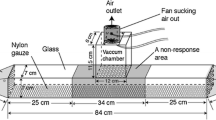Abstract
The sex pheromone for Anomala octiescostata has been previously identified as a 4:1 mixture of (R)-buibuilactone and (R)-japonilure. Field experiments showed that although not active per se, the secondary component increased the activity of major component, buibuilactone. The enantiomers of these semiochemicals, i.e., (S)-buibuilactone and (S)-japonilure are neither attractants nor behavioral antagonists to the pheromone system of A. octiescostata. Chiral GC-EAD experiments demonstrated that, in marked contrast to the Japanese beetle and Osaka beetle, which can detect a stereoisomer not produced by their conspecific females, the male antennae of A. octiescostata lack olfactory receptor neurons (ORNs) tuned to (S)-buibuilactone. The same enantiomeric anosmia (inability to smell a compound) was also observed in Anomala cuprea male antennae. Both in a Y-olfactometer and field experiments, it was clarified that (S)-buibuilactone was not a behavioral antagonist for A. cuprea. Contrary to male antennae of both A. octiescostata and A. cuprea, which lack ORNs tuned to the nonnatural (S)-buibuilactone, fragrance evaluation by skilled perfumers revealed that the human nose can discriminate (both in intensity and quality) enantiomerically pure samples of (R)- and (S)-buibuilactone and japonilure.
Similar content being viewed by others
REFERENCES
Anonymous. 1989. Software for Statistical Visualization on the Apple Macintosh. JMP Introductory Guide. SAS Institute, Inc., Cary, North Carolina.
Butenandt, A., and Hecker, E. 1961. Synthese des Bombykols, des Sexual-Lockstoffes des Seidenspinners, und seiner geometrischen Isomeren. Angew. Chem. 73:349–353.
Fabro, S. 1981. Biochemical basis of thalidomide teratogenicity, pp. 159–178, in M. R. Juchau (ed.). Biochemical Basis of Chemical Teratogenicity. Elsevier, New York.
Fabro, S., Smith, R. L., and Willaims, R. T. 1967. Toxicity and teratogenicity of optical isomers of thalidomide. Nature 215:296.
Faigle, J. W., Keberle, H., Riess, W., and Schmid, K. 1962. The metabolic fate of thalidomide. Experientia 18:389–397.
Friedman, L., and Miller, J. G. 1971. Odor incogruity and chirality. Science 172:1044–1046.
Kohler, F., Meise, W., and Ockenfels, H. 1971. Teratologische Prüfung einiger Thalidomid-Metabolite, Experientia 27:1149–1150.
Larsson, M., Leal, W. S., Hansson, B. S. 1999. Olfactory receptor neurons specific to chiral pheromone components in male and female Anomala cuprea beetles (Coleoptera: Scarabaeidae). J. Comp. Physiol. A. In press.
Leal, W. S. 1991. (R,Z)-5-(−)-(Oct-1-enyl)oxacyclopentan-2-one, the sex pheromone of the scarab beetle Anomala cuprea. Naturwissenschaften 78:521–523.
Leal, W. S. 1996. Chemical communication in scarab beetles: Reciprocal behavioral agonist-antagonist activities of chiral pheromones. Proc. Natl. Acad. Sci. U.S.A. 93:12112–12115.
Leal, W. S., and Mochizuki, F. 1993. Sex pheromone reception in the scarab beetle Anomala cuprea: Enantiomeric discrimination in sensilla placodea. Naturwissenschaften 80:278–281.
Leal, W. S., Sawada, M., and Hasegawa, M. 1993. The scarab beetle Anomala cuprea utilizes the sex pheromone of Popillia japonica as a minor component. J. Chem. Ecol. 19:1303–1313.
Leal, W. S., Hasegawa, M., Sawada, M., Ono, M., and Ueda, Y. 1994. Identification and field evaluation of Anomala octiescostata (Coleoptera: Scarabaeidae) sex pheromone. J. Chem. Ecol. 20:1643–1655.
Leal, W. S., Shi, X., Liang, D., Schal, C., and Meinwald, J. 1995. Application of chiral gas chromatography with electroantennographic detection to the determination of the stereochemistry of a cockroach sex pheromone. Proc. Natl. Acad. Sci. U.S.A. 92:1033–1037.
Leal, W. S., Kuwahara, S., Ono, M., and Sakae, K. 1996. (R,Z)-7,15-Hexadecadien-4-olide, sex pheromone of the yellowish elongate chafer, Heptophylla picea. Bioorg. Med. Chem. 4:315–321.
Leitereg, T. J., Guadagni, D. G., Harris, J., Mon, T. R., and Teranishi, R. 1971. Evidence for the difference between the odours of the optical isomers (+) and (−)-carvone. Nature 230:455–456.
Matsuyama, S., Leal, W. S., Hasegawa, M., and Sawada, M. 1992. Is chirality essential for pheromonal activity in scarab beetles? The case of the large black chafer, H. parallela. Proceedings, 38th Annual Meeting of the Japan Society for Bioscience, Biotechnology, and Agrochemistry.
Ockenfels, H., and Kohler, F. 1970. Das L-isomere als teratogenes Prinzip der N-phthalyl-DL-glutaminsäure. Experientia 26:1236–1237.
Ono, M., Mori, M., and Leal, W. S. 1994. Development of pheromone traps. Nippon Nogeikagaku Kaishi 68:1281–1287 (in Japanese).
Piutti, M. A. 1886. Sur une nouvelle espece d'asparagine. C.R. Acad. Sci. 103:134–138.
Russel, G. F., and Hills, J. I. 1971. Odor differences between enantiomeric isomers. Science 172:1043–1044.
Seybold, S. 1993. Role of chirality in olfactory-directed behavior: Aggregation of pine engraver beetles in the genus Ips (Coleoptera: Scolytidae). J. Chem. Ecol. 19:1809–1831.
Silverstein, R. M. 1979. Enantiomeric composition and bioactivity of chiral semiochemicals in insects, pp. 133–146, in R. J. Ritter (ed.). Chemical Ecology: Odour Communication in Animals. Elsevier, Amsterdam.
Silverstein, R. M., Rodin, J. O., Wood, D. L., and Browne, L. E. 1966. Identification of two new terpene alcohols from frass produced by Ips confusus in ponderosa pine. Tetrahedron 22:1929–1936.
Stinson, S. C. 1993. Chiral drugs. Chem. Eng. News 39:38–64.
Tumlinson, J. H., Klein, M. G., Doolittle, R. E., Ladd, T. L., and Proveaux, A. T. 1977. Identification of the female Japanese beetle sex pheromone: Inhibition of male response by an enantiomer. Science 197:789–792.
Wnendt, S., and Zwingenberger, K. 1997. Thalidomide's chirality. Nature 385:303–304.
Wojtasek, H., Hansson, B. S., and Leal, W. S. 1998. Attracted or repelled—a matter of two neurons, one pheromone binding protein, and a chiral center. Biochem. Biophys. Res. Commun. 250:217–222.
Zhang, A., Robbins, P. S., Leal, W. S., Linn, Jr., C. E., Villani, M. G., and Roelofs, W. L. 1997. Essential amino acid methyl esters: major sex pheromone components of the cranberry white grub, Phyllophaga anxia (Coleoptera: Scarabaeidae). J. Chem. Ecol. 23:231–245.
Author information
Authors and Affiliations
Rights and permissions
About this article
Cite this article
Leal, W.S. Enantiomeric Anosmia in Scarab Beetles. J Chem Ecol 25, 1055–1066 (1999). https://doi.org/10.1023/A:1020877724761
Issue Date:
DOI: https://doi.org/10.1023/A:1020877724761




